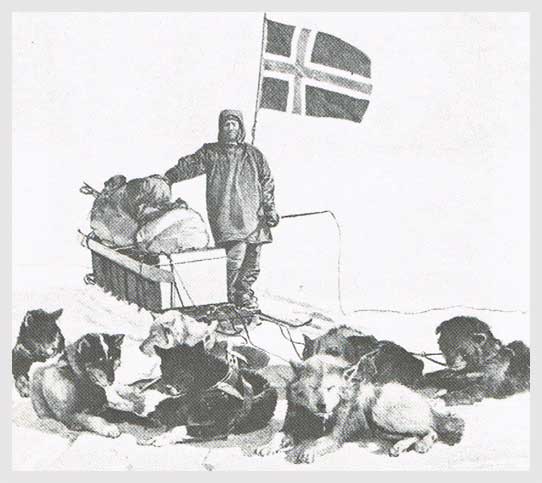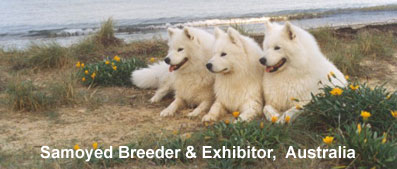A Brief History of the Samoyed Dog
The SAMOYEDE peoples are of Mongolian descent.They probably migrated to Taimyr Peninsular in Northwestern Siberia about the time of Christ. They are short in stature, have yellowish skin, high cheek bones and concave noses.
(There are less than 50,000 of them left today.)
They are nomadic people who follow the herds of reindeer across the tundra in their never ending search for the lichen that is the reindeers staple diet. They were in family groups and travelled with their dogs.
The SAMOYEDE people depended on their reindeer. As well as a food source, they made collapsible tents of saplings and reindeer hide.The reindeer were used to haul these tents and their other possessions.Their clothes were long, hooded parkas made of reindeer skins with the fur turned inwards, and tools were made from the reindeer bones and of course they ate the reindeer meat.
The SAMOYEDE people were known for their "Bjelkiers" (white dog that breeds white)
These dogs could hunt, haul and herd and enjoyed doing it all. The puppies were given a special place in the tents (chooms) and a strong partnership was formed between man and dog. The dogs were allowed complete freedom of movement as they were gentle and likable.The Bjelkier dog could be trusted to baby-sit the Samoyede peoples offspring, yet, when necessary, a pack of Beljkiers could drive off Polar Bears weighing over 1500 pounds, and packs of wolves.
In the 17th and 18th century the Russians began exploring Siberia and recognised the attributes of the Bjelkier.Their beauty won them stature in the Czar's family and occasionally one was given as a very special gift to other European nobility.They attained "royal" status and were protected from all outsiders.The Russians quickly saw value in using them for pulling the sleds of the tax collectors and also the sleds of their explorers in Siberia.
Their reputation among explorers soon got around.
A professor at the Norwegian University and explorer, Fidtjof Nansen, used these dogs on his numerous expeditions in the Arctic, many of which were brutal for the dogs. Many dogs died needlessly because the explorers did not understand anatomy and physiology and they did things that put the dogs in jeopardy They bobbed their beautiful curved tails, that caused pneumonia because the tail acts as a pre-filter to warm and humidify the air that is inhaled.They even sheared their coats causing them to freeze, and he also fed the weaker dogs to the strong, rather than hunt seal or carry food for them.
Roald Amundsen, another Norwegian in 1911 made a 1,860 round trip in 99 days to the South Pole.The first to the South Pole was his lead Bjelkier. He used 52 dogs in all to pull 4 sleds. After returning these dogs were given to other explorers and some made their way to England. Many of our dogs today are direct descendants of these dogs.

Samoyed across the South Pole with the Roald Amundsen Expedition
On Captain Robert Scott's expedition to the Antarctic he used horses as his main source of locomotion.He also took 33 Bjelkiers, but someone had bobbed their tails. They all died of pneumonia within 3 weeks.The 6 members of Scott's team hauled the remaining equipment to the South Pole, only to find the Bjelkier paw prints and a note from Amundsen.who had got there a month earlier.
Beaten physically and emotionally Scott died on the way back.
In England, Mr.Earnest Kilburn-Scott of the Royal Zoological Society became a big influence on the breed. In 1880 on an expedition to Archangle a very cute, white, plump puppy caught his attention, and he took it back to the UK as a gift for his wife
He later brought some dogs and pups from Siberia and some dogs from the explorers.
The Kilburn-Scotts developed the breed in England.
Because of their beauty and friendliness they fast became very popular with the "well to do" and the titled, influential people.
The Kennel Club initially allowed them to be shown in the "Foreign Class"at English shows.
In 1909 the Kilburn-Scotts founded the first Samoyede Club, and Samoyede became the official name of the Bjelkier, naming the dogs after the people they came from.
The Samoyede was first shown in its own classification in 1912.
In 1923 the English Kennel Club dropped th "e" from the end of the name, and in 1947 the America Kennel Club did the same. Shortly after, the name began to be mispronounced.
Instead of Sahm-uh-yed (native pronunciation) the name became anglicized to Sahm-oid.
Which is what we call our beautiful breed today. |





